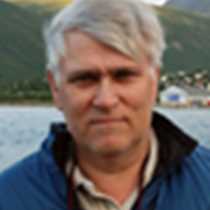Eastern Svalbard
If yesterday was about sea ice and polar bears, today turned into euphoria with glacier ice and again more polar bears.
Throughout the “night” as we were sound asleep (if you even can speak about “nights” as here there is 24 hours daylight until late August), the ship had sailed along the major ice cap edge of Austfonna. During breakfast we approached the southwestern end for a closer look at the ice cap and its ice front with some impressive waterfalls. Austfonnna, together with its western counterpart, Vestfonna, covers more than 60% of Nordaustlandet (the second-largest island in Svalbard), producing the third-largest ice cap in the world…after Antarctica and Greenland.
Later in the morning, we sailed westwards towards the main island Spitsbergen and had an opportunity to learn more about polar bears and their biology. Yesterday, with all the bears on the pack-ice, we observed much polar bear behavior and many of us wanted to learn more about what we had seen. A lecture this afternoon answered many of our questions, but as always with living creatures, you can never find all answers. Polar bears are solitary animals in an extreme environment and through evolution for more than 200,000 years have adapted to survive on the sea ice in the High Arctic with pitch darkness for almost 6 months. This is, of course, an environment we humans have very little concept of survival and understanding.
Right after lunch, we approached Björnsundet (Bear Sound) and found some fast ice in the very interior. We soon had more polar bear euphoria. The name of the place is very proper for the area and our captain set the ship into the fast ice. Exactly how many bears we saw in total is hard to state, but consensus was reached at 15. Here, we also had the opportunity to encounter some females with “coy” (cubs of the year). One female and her cub wandered more than a mile right up to the ship. Later, a solitary bear also decided to investigate the strange smell and came up to become yet another photo target.
Soon we set sail for Heleysundet, a narrow passage that divides Spitsbergen and Barentsöya. The tide creates a rushing river and navigation becomes a challenge with very nice scenery, including cliffs of columnar dolorite where large numbers of gulls and auks breed. To our surprise, our polar bear luck continued, and several more polar bears got counted along the cliffs. We even saw a female and her two cubs being chased by a “nasty” old male.
It was hard to believe yesterday’s polar bear euphoria would be followed by another day with even more polar bears. To end the day, we went for more of what we started with… glaciers. We now were sailing in Storfjord and decided to head for Negribreen, named for a famous Italian geographer Baron Christoforo Negri. After dinner we slowly cruised along the glacier front and found several rivers running out with melt water. These rivers produce micro-upwellings, which create feeding opportunities for thousands of birds.
For sure, the High Arctic houses amazing opportunities for photography and before retiring tonight in anticipation of more polar adventures yet to come, many of us had to spend time downloading photo memory cards in order to have fresh memory capacity ready for tomorrow.




